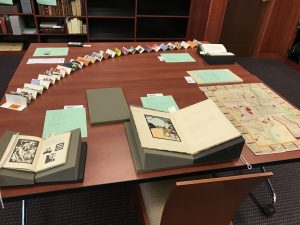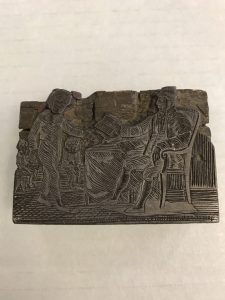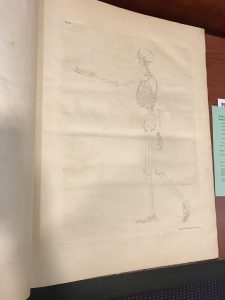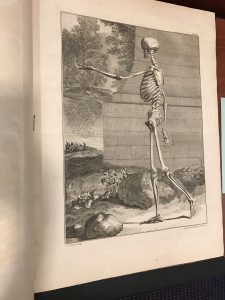SCRC has an active instruction schedule during the academic year, as professors from all departments bring their students in to see the amazing materials housed in Special Collections. However, many may be surprised to learn that SCRC houses objects, texts, and ephemera related to virtually every discipline.This week included a reminder of how rich a collection we have related to the arts. Professor Brian Kreydatus brought in his ART324 Relief Printmaking class to view the vast array of materials we have pertaining to the book arts and printmaking.
|

|
 39.1H38.A2: Woodcut boy and man with book Woodcut, wooden block used for printing. Block depicts a boy and a man with a book in the foreground, two boys in the background. Inked and dried. 1.75 in. x 2.5 in. x 0.75 in. Transferred from Box 1 of the Henkel Family Papers. Located in Art S5 SS1, Box 1. Mss. 39.1H38.A02
39.1H38.A2: Woodcut boy and man with book Woodcut, wooden block used for printing. Block depicts a boy and a man with a book in the foreground, two boys in the background. Inked and dried. 1.75 in. x 2.5 in. x 0.75 in. Transferred from Box 1 of the Henkel Family Papers. Located in Art S5 SS1, Box 1. Mss. 39.1H38.A02 |
While what we pulled for them to see scratched only the surface of our collections, the materials they looked at included woodblocks, original prints, handmade books, and texts on the art of printing, as well as a special edition of Melville’s Moby Dick featuring prints by Rockwell Kent. Other highlights include print blocks from the Henkel Family Papers collection, featuring charming animals and the one shown here that depicts human subjects interacting.
Perhaps most unusual and incredibly fascinating for those interested in art, printmaking, and/or anatomy, is the book, Tables of the Skeleton and Muscles of the Human Body by Bernhard Siegfried Albinus (1697-1770), printed in London in 1749. The very large text contains intricate engravings illustrating, among other subjects, skeletons presented both anatomically with numbers identifying the various bones, and as part of a visual narrative, shown moving through the landscape as if alive. In one plate, the skeleton stands in front of a large rhinoceros, creating (even if it was not Albinus’s intention) a particularly humorous vignette. While unusual, Albinus hoped that situating the skeletons in lush, natural settings would “emphasize the harmonious and natural beauty of the body,” relieving some of the macabre associations viewers may have had with the skeletal form.[1]
 Tables of the Skeleton and Muscles of the Human Body by Bernhard Siegfried Albinus (1749)
Tables of the Skeleton and Muscles of the Human Body by Bernhard Siegfried Albinus (1749)
 Tables of the Skeleton and Muscles of the Human Body by Bernhard Siegfried Albinus (1749)
Tables of the Skeleton and Muscles of the Human Body by Bernhard Siegfried Albinus (1749)
 Tables of the Skeleton and Muscles of the Human Body by Bernhard Siegfried Albinus (1749)
Tables of the Skeleton and Muscles of the Human Body by Bernhard Siegfried Albinus (1749)
Throughout the book, engravings depict the human form as a layered one; indeed, Albinus wanted to transcend knowledge and study of the exterior of the human body and look more deeply at the various layers of flesh and muscle that comprise its form. Containing some of the most accurate depictions of the human body, Albinus’s text was used for many years as the ultimate educational text on anatomy. For more than eight years, Albinus and the artist-engraver Jan Wandelaar worked to create the 40 plates included in the book, striving not only for scientific accuracy but also aesthetic appeal, and the result is truly astonishing.[2]
[1] Bernhard Siegfried Albinus (1697-1770),” University of Virginia, Historical Collections at the Claude Moore Health Sciences Library, 2007. http://exhibits.hsl.virginia.edu/treasures/bernhard-siegfried-albinus-16....
[2] Bernhard Siegfried Albinus (1697-1770),” University of Virginia, Historical Collections at the Claude Moore Health Sciences Library, 2007. http://exhibits.hsl.virginia.edu/treasures/bernhard-siegfried-albinus-16....